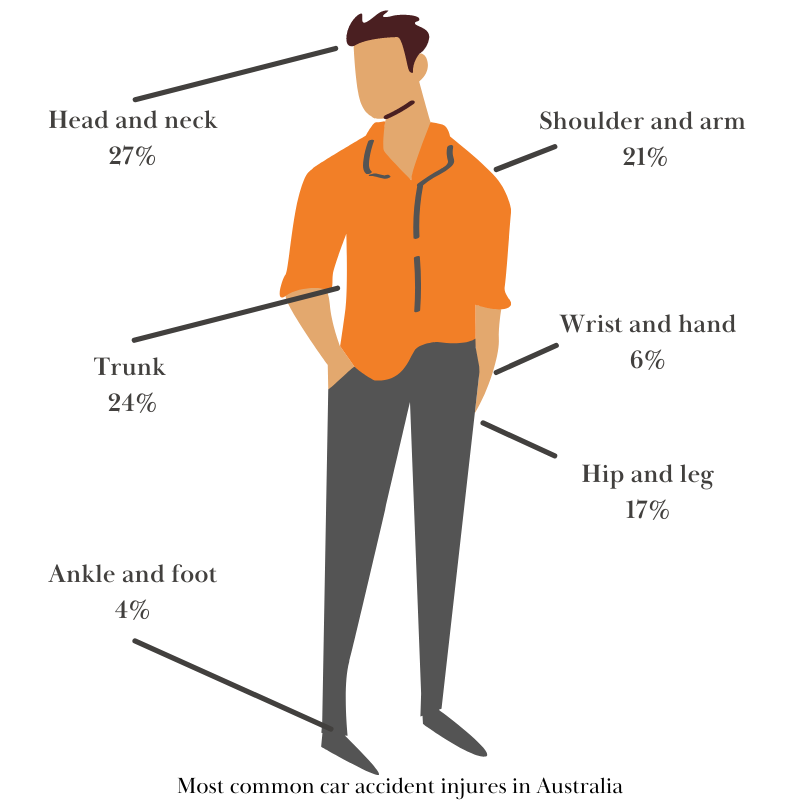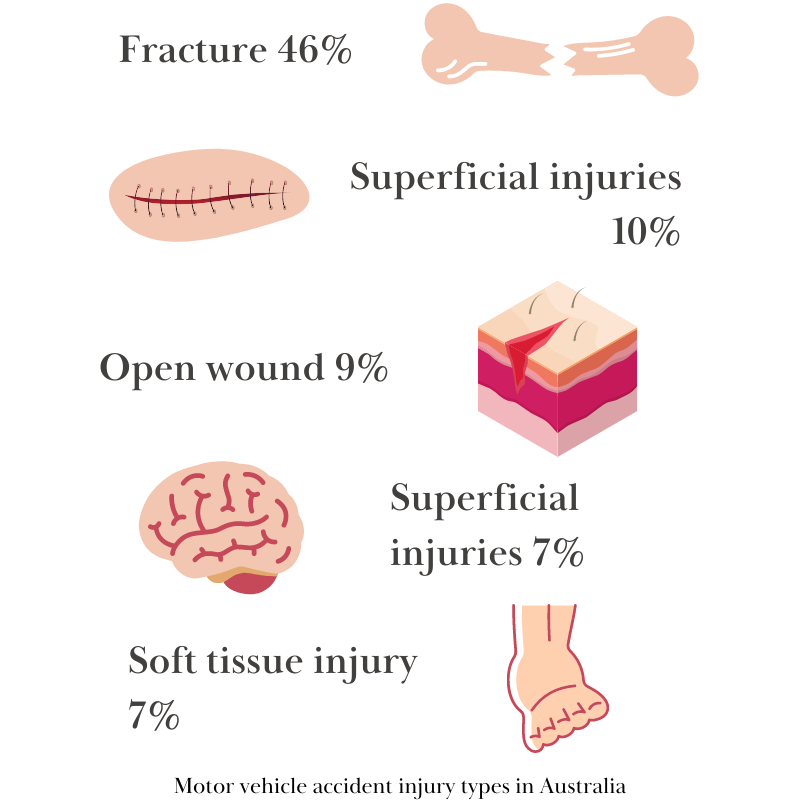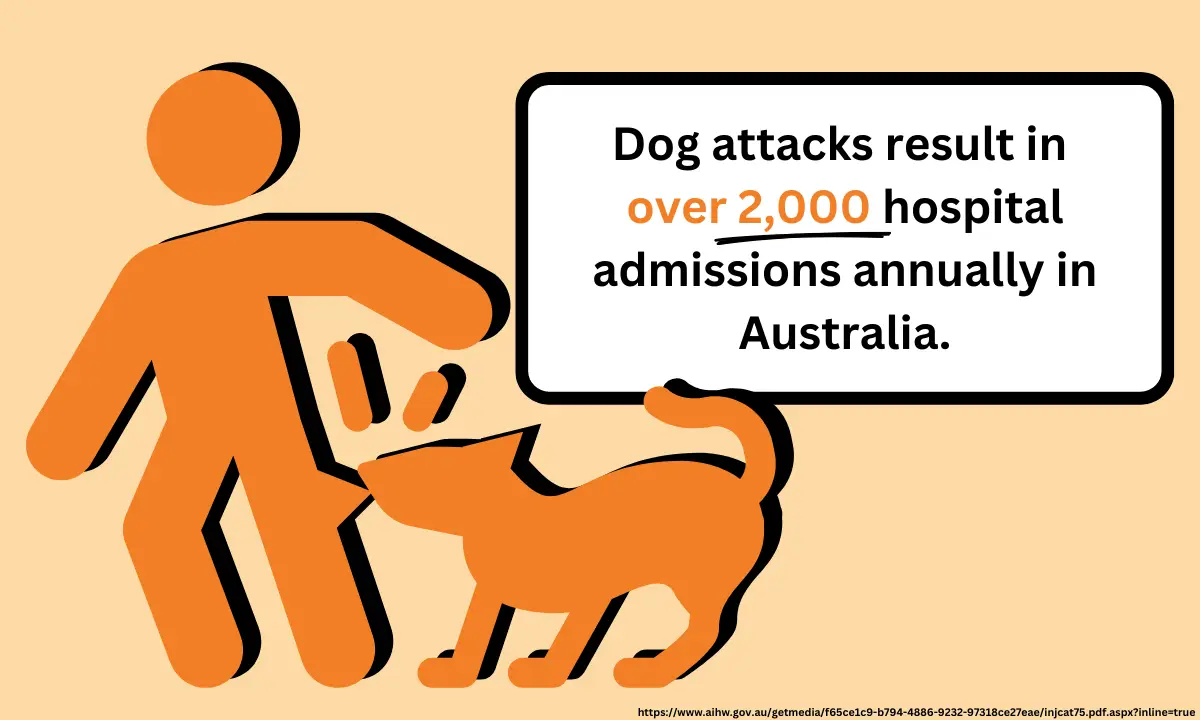According to the Australian Institute of Health and Welfare, the number of people who have sustained car accident injuries that are hospitalised in Australians increased dramatically and reached more than 60,000 cases in 2019. As for fatalities from car accidents,thanks to technological developments, the number of fatalities has been decreasing but still unfortunately each year almost 1,500 people lose their lives. If you have also sustained a car accident injury it is important you are aware you are not alone and may be entitled to compensation. Reach out to our car accident injury lawyers for a free eligibility claim check.
What are the most common car accident injuries?

The above demonstrates the percentage on average of injuries according to our estimate that are sustained from car accident injuries.
The most common car accident injuries we see are listed below:
1. Head and neck injuries
Head and neck injuries comprise the highest percentage of car accident injuries in Australia. These injuries include:
Whiplash injury
Whiplash is one of the most common neck injuries that occur due to a strong head jolt. The seatbelt keeps the driver and passengers safe and prevents more serious damage in the case of sudden deceleration however, when another vehicle hits you, the neck is typically left unsupported, resulting in strain on the muscles and tendons in your neck and upper back.
Whiplash injuries don’t appear in scans and pathology however, they can feel very painful for a long time.
Traumatic brain injury
Traumatic brain injuries occur due to a violent jolt or blow of the head that damages the brain tissue. Serious car accidents may cause such injury and may leave serious impairments on the injured person’s life such as cognitive, physical, and emotional deterioration.
Head & concussion injury
Concussion and skull fractures arise due to serious car accidents that generally have a significant effect on the injured person’s life. They may cause long-term disability and the injured person may need lifetime personal care.
2. Trunk injuries
Trunk injuries cover all injuries on the chest, back abdomen, and spinal parts of the body. These injuries include:
Back injury
Back injuries include bone, joint, tissue, muscle, and nerve damage extending from the neck to pelvis. These injuries not only arise due to a car accident but also happen due to repetitive movements, wrong posture, older age etc.
Spinal cord injury
Some car accident victims suffer spinal cord injuries that damage the spine and cause mobility deterioration of the injured person. Spinal cord injuries can cause disability and low life quality.
3. Shoulder and arm injuries
The majority of shoulder and arm injuries include amputation of the limbs and fractures of the bones. Broken bones generally heal rapidly however amputation may cause permanent disability.
4. Hip and leg injuries
Leg and hip injuries are common in car and motorcycle accidents. Legs under pressure can sustain crush injury, and hip injuries can occur in a way of fracture, bursitis, and dislocation. Both injuries may limit the daily life of the injured person.
5. Wrist and hand injuries
Broken bones comprise the majority of car accident-related hand and wrist injuries. Depending on the injury type, these injuries may require surgery for an injured person to go back to their daily life.
6. Ankle and foot injuries
Even though ankle and foot injuries are not the most common injury types, they may occur in a way of strains, ligament, and tendon damages due to a motor vehicle accident impact.
7. Bruising, Burns and Lacerations
You may also suffer bruising or burns from your seatbelt or airbag deployment as a result of a car accident. Burns sometimes lead to scarring, so it is recommended to seek urgent medical advice and treatment from your qualified doctor.
Lacerations may also occur from your seatbelt restraint, airbags deployment or shattered windscreen or contact with sharp objects. Lacerations can be minor or more complex wounds which may require surgery which may take a significantly long time to resolve. In some cases, lacerations lead to scarring and disfigurement.
This information is informative and not a substitute for medical advice. Learn more about transport accident injuries from the Australian Institute of Health and Welfare here.
What are the most common car accident injury types?

Fractures are the most common injury types in car accident injuries in Australia. Apart from fractures, superficial injuries, open wounds, brain traumas, soft-tissue injuries, internal organ injuries, dislocations and burns are the common injury types, respectively.
Car accident injuries injury demographics in Australia

- Australians between the age of 15-24 comprise 40% of the total injured people. People between 25-44 and 5-14 follow this group.
- The injury rate of kids between the age of 0 to 4 is the lowest amongst all age groups.
- 66% of the hospitalised people are males.
- People from remote areas get injured 2.5 times more than people in major cities.
What are the car accident injuries compensation entitlements in Australia?
Injuries don’t always appear immediately. In fact sometimes injuries after a car accident appear later. Usually, though, the body is shocked and pumped with adrenaline at the time of the accident, so you may not feel the pain until your body cools down and your shock subsides. The onset of pain, whether psychological or physical, may appear hours, days, weeks or months later and it is important to speak to your doctor when your injury appears to ensure that it is recorded in your medical file.
There are strict time limits that apply to claiming compensation for your car accident injury and we recommend you contact our car accident lawyers for a free eligibility claim check to know where you stand based on your specific circumstances.
I have been injured in a car accident, what are my compensation entitlements:
Reasonable and necessary medical and treatment expenses including rehabilitation and hospital costs.
A percentage of your pre-accident weekly earnings if you need to take time off work as a result of your injuries
if you need help while you recover.
A lump sum payout to take into account your future loss of earning capacity if you were not mostly at fault and have non-minor injuries
A lump sum payout to take into account your pain and suffering if your physical or psychological injuries are assessed as being greater than 10% whole person impairment.

Can I claim compensation for back injury in a car accident?
Regardless of the injury type, whether back or not, whether you were a driver, passenger, rider or pillion passenger, pedestrian or cyclist, if you were injured in a car accident in NSW, you can make a compensation claim for lost income and medical expenses.
If your injuries are non-minor and you were not mostly at fault, then you can claim compensation benefits beyond 6 months and also claim a lump sum payout to take into account your future earning capacity as a result of the accident.
Your injuries can be physical or psychological.
However, you may not be able to make a successful car accident claim if you have been charged with or convicted of a serious driving offence in connection with the subject accident or, were the at fault driver of an unregistered vehicle and you knew the vehicle was unregistered. The circumstances around whether you can or cannot claim are specific to your circumstances. Please reach our car accident lawyers to obtain specific information about your eligibility and entitlements.
If your injury is as a result of a motor accident that is also a work-related accident, you should make a worker’s compensation claim against your employer’s workers compensation insurer. You can read more about your workers compensation entitlements for your work related injury here or contact our workers compensation lawyers who will provide you with a free eligibility claim check.
How long after a car accident can I claim injury?
You must lodge the Personal Injury Benefits Form with a completed Certificate of Capacity to the CTP Insurer of the vehicle at fault within three months after the date of the accident, or within 28 days if you want to claim lost income (back pay) for loss of income from the date of the accident. If the insurer accepts liability for your claim, it should start weekly payments and medical expenses within 14 days.
If your injuries were determined as being non-minor then you are also entitled to lodge an Application for Modified Common Law damages to claim a lump sum payout for your car accident injury at 20 months from the date of the accident unless your injuries were also determined as being greater than 10% whole person impairment, then it can be sooner.
You are required to provide particulars regarding your injuries, losses and evidence usually by 26 months from the date of your cart accident injury.
In NSW, you have three (3) years from the date of the accident to file in the Personal Injury Commission otherwise you will be out of time to claim a lump sum payout.
If your accident occurred in WA, acces our Car Accident Compensation Lawyers WA page.
How long after a car accident can I claim injury?
Our experienced car accident injury lawyers can assist you to get maximum accident compensation payout possible on a No Win No Fee basis.
We offer a free claim check and will provide you with insight as to your eligibility to claim compensation. Injuries that occur due to car accidents can affect your future ability to earn and our car accident lawyers will explain to you your entitlements, how to claim them and the best way forward in maximising your entitlements to compensation.
In addition to car accident compensation, we can also help with:
- Motorcycle and scooter accident compensation
- Bike accident compensation
- Truck accident compensation
- Public transport accident compensation
- Pedestrian accident compensation
Call us on 1800 952 901 or fill in the free claim assessment form below for further information.

Issa Rabaya
• Bachelor of Laws
• Graduate Diploma in Legal Practice
• Approved Legal Service Provider to the Work Cover Independent Review Office
• Member of the Law Society





